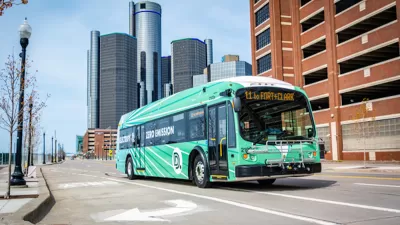Crowd-funded plans to build a statue of the movie character RoboCop are moving ahead in Detroit, and the project is redefining public participation in civic ventures.
Thousands of people, mainly from outside of Detroit, contributed more than $50,000 to help build the statue.
"It might not be exactly what the city of Detroit needs, but it is something. Dramatic population losses and evaporating jobs have put the city in a state of gradual decay that shows few signs of stopping. That caricature was even more pronounced in RoboCop the film, where crime was rampant and a virtually indestructible robot was the only thing that could stop the city from self-destruction. Brandon Walley, one of the organisers behind the statue campaign, says the plot still resonates in a city fighting for identity and struggling to persevere. 'I don't want to take it too far, but there are these parallels with Detroit that are interesting,' says Walley. 'This city needs so much. I'll be the first to admit that that money should go somewhere else, but there's nothing wrong with a bunch of people wanting to have fun.'
Most city governments long for this kind of interest in local decision-making, and they're increasingly relying on the Internet to provide such easy access to what's otherwise a timesuck at city hall. A pop culture statue doesn't exactly carry the same weight as a debate over a sales tax increase or a new mega-development, but Walley says it does represent a positive change for the city that locals and outsiders should get behind. As the project is privately funded, privately organised and slated to go up on land owned by Wayne State University, the City of Detroit is officially agnostic.
"
FULL STORY: Open Source Design 03: RoboCop: The Monument

Alabama: Trump Terminates Settlements for Black Communities Harmed By Raw Sewage
Trump deemed the landmark civil rights agreement “illegal DEI and environmental justice policy.”

Planetizen Federal Action Tracker
A weekly monitor of how Trump’s orders and actions are impacting planners and planning in America.

The 120 Year Old Tiny Home Villages That Sheltered San Francisco’s Earthquake Refugees
More than a century ago, San Francisco mobilized to house thousands of residents displaced by the 1906 earthquake. Could their strategy offer a model for the present?

Ken Jennings Launches Transit Web Series
The Jeopardy champ wants you to ride public transit.

BLM To Rescind Public Lands Rule
The change will downgrade conservation, once again putting federal land at risk for mining and other extractive uses.

Indy Neighborhood Group Builds Temporary Multi-Use Path
Community members, aided in part by funding from the city, repurposed a vehicle lane to create a protected bike and pedestrian path for the summer season.
Urban Design for Planners 1: Software Tools
This six-course series explores essential urban design concepts using open source software and equips planners with the tools they need to participate fully in the urban design process.
Planning for Universal Design
Learn the tools for implementing Universal Design in planning regulations.
Clanton & Associates, Inc.
Jessamine County Fiscal Court
Institute for Housing and Urban Development Studies (IHS)
City of Grandview
Harvard GSD Executive Education
Toledo-Lucas County Plan Commissions
Salt Lake City
NYU Wagner Graduate School of Public Service




























